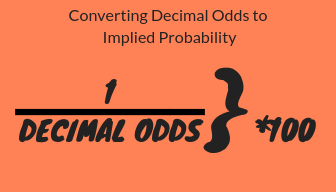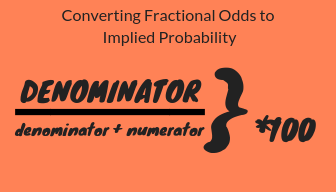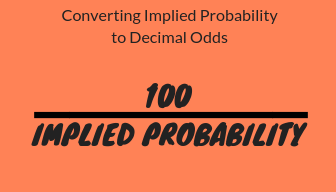If you have wondered about the term Implied Probability when it comes to betting, or have either just glossed over it or don’t fully understand it, then here’s a guide to what it means.
In our Implied Probability guide, we even show you how to calculate it.
What is Implied Probability?
Implied Probability is what a bookmaker thinks is the chance of an outcome happening in a sports event. For example, if Barcelona are 9/5 to beat Real Madrid in a match, those odds are based on the calculation of what the bookmaker expects to happen in the match.
If you convert the 9/5 fractional odds to an Implied Probability, then the bookmaker thinks that’s a 35.7% chance of Barca winning the game.
Remember in a football match that will be one of three outcomes that could happen (home win, draw, away win). So based on how they think an event will play out, the bookmark will set their odds by that.
All Odds Included
So all odds that you see listed in a sportsbook are based on an Implied Probability. It’s basically an assumption made by the bookmaker’s traders really. That is why when you see a big price such a 5/1 on a player to win a tennis match, you know that there is little chance of that happening. Converted out that is a 16.7% probability.
So judging things from that then, you can decide whether the bookmaker is offering value on an event outcome. Maybe in your estimate, they have underestimated a team’s chances and that is where you can try and nab some value by really taking on the bookie.
Important
Understanding Implied Probability is so important as it is directly related to the value in a particular betting market.
Conversion
It’s pretty easy to convert odds to a probability so you can work things out for yourself. It is a lot easier if it is done through decimal odds. You just divide the odds by one and then multiply by 100.
So odds of 1.54
1/1.54 = .065
0.65 * 100 = 65% Implied Probability
There is a little more work to do in getting to the bottom of a Fractional Odds conversion to Implied Probability. The basics of it are that you divide denominator + numerator by the denominator.
So example odds 6/4
6/(6 + 4)
6/10 = 0.6
0.6 * 100 = 60% Implied Probability
Your Own Implied Probability
Value bets. That is why you may want to start things off with Your Own Implied Probability. Let’s say that you are looking at Manchester City v Manchester United and fancy the Red Devils to get a win. You look at all the stats, read the current form, and then come to a conclusion that you think there is a good 40% chance of them winning the game.
So based on your own computations you could then go and convert that Implied Probability that you have come up with, into odds. You simply divide your implied probability by 100 and that’s it. So with your 40% estimate, you would do 100 / 40 which is 2.5 decimal odds.
So now you can look at a bookmaker and see if there is someone matching those odds or even better, offering extra value based on your interpretation of forthcoming events, by offering a bigger price (value bet). So it’s very useful to know all of this Implied Probability and what the odds actually mean.
Skip the work
Of course all of this would be made a lot easier if you could just press a button and see what the Implied Probability of odds are. Fortunately enough there is a betting calculator right here that you can bookmark for future use! Just plug in the odds and it automatically converts to probability.
Bookmaker Edge
The percentages above are not a true reflection of an outcome. What we mean by that and this is important to bear in mind although it won’t really affect your betting too much, that things are not quite what they seem. We look at odds from a recent Croatia v England soccer match.
Croatia 8/5
England 9/5
Draw 2/1
It’s straight forward. Croatia were favourites with a 38.5% Implied Probability against England’s 35.7% chance. Then, of course, you have to throw in the draw outcome.
If you add together 38.5 and 35.7 that adds up to 74.2%. So what is left should be a 25.8% chance on the draw outcome (to add up to 100% across the three options). But the odds on the draw at 2/1 convert to a 33% Implied Probability.
38.5 + 35.7 + 33 = 107.2%
So what’s that about? That extra seven per cent is basically the bookmaker’s edge. The odds are inflated on each of the outcomes so that no matter what does actually play out on the field of play, the bookie will end up winning in some way.
To explain this a little bit better imagine a flip of a coin which is a 50/50 chance.
In a perfect world the bookie would offer 2.0 odds on each outcome. But the bookmaker instead has 1.98 odds on each outcome instead of the perfectly balanced 2.0 odds. 1.98 decimal odds equates to
So if you bet 100 on heads and it was heads, you collect a 98 profit so the bookie gains 2.
If the flip had come up tails they would have kept the 100 stake, so they win either way. That’s what the edge (in a very simplistic example) is all about.
So the Implied Odds ALWAYS include the bookmaker edge.













